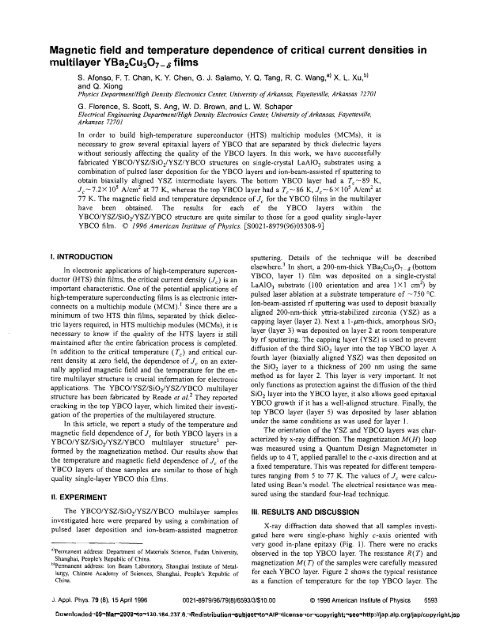Three - University of Arkansas Physics Department
Three - University of Arkansas Physics Department
Three - University of Arkansas Physics Department
You also want an ePaper? Increase the reach of your titles
YUMPU automatically turns print PDFs into web optimized ePapers that Google loves.
Magnetic field and temperature dependence <strong>of</strong> critical current densities in<br />
multilayer YB~,CU~O~-~<br />
films<br />
S. Afonso, F. T. Chan, K. Y. Chen, G. J. Salamo, Y. Q. Tang, R. C. ~ang,~) X. L.<br />
and Q. Xiong<br />
<strong>Physics</strong> Deparhzent/High Density Electronics Center: <strong>University</strong> <strong>of</strong> <strong>Arkansas</strong>, Fayetteville, <strong>Arkansas</strong> 72701<br />
G. Florence, S. Scott, S. Ang, W. D. Brown, and L. W. Schaper<br />
Electrical Engineering <strong>Department</strong>/High Demity Electronics Centec <strong>University</strong> <strong>of</strong> <strong>Arkansas</strong>, FayetlevzlIe,<br />
<strong>Arkansas</strong> 72701<br />
In order to build high-temperature superconductor (HTS) multichip modules (MCMs), it is<br />
necessary to grow several epitaxial layers <strong>of</strong> YBCO that are separated by thick dielectric layers<br />
without seriously affecting the quality <strong>of</strong> the YBCO layers. In this work, we have successfully<br />
fabricated YBCO/YSZ/SiO,/YSZ/YBCO structures on single-crystal LaA103 substrates using a<br />
combination <strong>of</strong> pulsed laser deposition for the YBCO layers and ion-beam-assisted rf sputtering to<br />
obtain biaxially aligned YSZ intermediate layers. The bottom YBCO layer had a T,-89 K,<br />
J,-7.2x lo5 A/cm2 at 77 K, whereas the top YBCO layer had a T,-86 K, J,-6X lo5 A/cm2 at<br />
77 K. The magnetic field and temperature dependence <strong>of</strong> J, for the YBCO films in the multilayer<br />
have been obtained. The results for each <strong>of</strong> the YBCO layers within the<br />
YBCOIYSZISi021YSZIYBC0 structure are quite similar to those for a good quality single-layer<br />
YBCO film. O 1996 American Institute <strong>of</strong> <strong>Physics</strong>. [S0021-8979(96)03308-91<br />
I. INTRODUCTION sputtering. Details <strong>of</strong> the technique will be described<br />
In electronic applications <strong>of</strong> high-temperature supercone~sewhere.~<br />
In short, a 200-nm-thick YB~,CU~O,-~ (bottom<br />
ductor (HTS) thin films, the critical current density (J,) is an<br />
important characteristic. One <strong>of</strong> the potential applications <strong>of</strong><br />
high-temperature superconducting films is as electronic interconnects<br />
on a multichip module (MCM).' Since there are a<br />
minimum <strong>of</strong> two HTS thin films, separated by thick dielectric<br />
layers required, in HTS multichip modules (MCMs), it is<br />
necessary to know if the quality <strong>of</strong> the HTS layers is still<br />
maintained after the entire fabrication process is completed.<br />
In addition to the critical temperature (T,) and critical current<br />
density at zero field, the dependence-<strong>of</strong> J, on an externally<br />
applied magnetic field and the temperature for the entire<br />
multilayer structure is crucial information for electronic<br />
applications. The YBCO/YSZ/Si02/YSZ/YBC0 multilayer<br />
structure has been fabricated by Reade et 01.' They reported<br />
cracking in the top YBCO layer, which limited their investigation<br />
<strong>of</strong> the properties <strong>of</strong> the multilayered structure.<br />
In this article, we report a study <strong>of</strong> the temperature and<br />
magnetic field dependence <strong>of</strong> J, for both YBCO layers in a<br />
YBCO/YSZISi021YSZIYBC0 multilayer structure3 performed<br />
by the magnetization method. Our results show that<br />
the temperature and magnetic field dependence <strong>of</strong> J, <strong>of</strong> the<br />
YBCO layers <strong>of</strong> these samples are similar to those <strong>of</strong> high<br />
quality single-layer YBCO thin films.<br />
II. EXPERIMENT<br />
The YBCO/YSZ/SiO,/YSZ/YBCO multilayer samples<br />
investigated here were prepared by using a combination <strong>of</strong><br />
pulsed laser deposition and ion-beam-assisted magnetron<br />
"permanent address: <strong>Department</strong> <strong>of</strong> Materials Science, Fudan <strong>University</strong>,<br />
Shanghai, People's Republic <strong>of</strong> China.<br />
"permanent address: Ion Beam Laboratory, Shanghai Institute <strong>of</strong> Metallurgy,<br />
Chinese Academy <strong>of</strong> Sciences, Shanghai, People's Republic <strong>of</strong><br />
China.<br />
YBCO, layer 1) film was deposited on a single-crystal<br />
La.410, substrate (100 orientation and area I Xl cm2) by<br />
pulsed laser ablation at a substrate temperature <strong>of</strong> -750 "C.<br />
Ion-beam-assisted rf sputtering was used to deposit biaxially<br />
aligned 200-nm-thick yttria-stabilized zirconia (YSZ) as a<br />
capping layer (layer 2). Next a 1-pm-thick, amorphous SiOz<br />
layer (layer 3) was deposited on layer 2 at room temperature<br />
by rf sputtering. The capping layer (YSZ) is used to prevent<br />
diffusion <strong>of</strong> the third SiO, layer into the top YBCO layer. A<br />
fourth layer (biaxially aligned YSZ) was then deposited on<br />
the SiO, layer to a thickness <strong>of</strong> 200 nm using the same<br />
method as for layer 2. This layer is very important. It not<br />
only functions as protection against the diffusion <strong>of</strong> the third<br />
SiOz layer into the YBCO layer, it also allows good epitaxial<br />
YBCO growth if it has a well-aligned structure. Finally, the<br />
top YBCO layer (layer 5) was deposited by laser ablation<br />
under the same conditions as was used for layer 1.<br />
The orientation <strong>of</strong> the YSZ and YBCO layers was characterized<br />
by x-ray diffraction. The magnetization M(H) loop<br />
was measured using a Quantum Design Magnetometer in<br />
fields up to 4 T, applied parallel to the c-axis direction and at<br />
a fixed temperature. This was repeated for different temperatures<br />
ranging from 5 to 77 K. The values <strong>of</strong> J, were calculated<br />
using Bean's model. The electrical resistance was measured<br />
using the standard four-lead technique.<br />
Ill. RESULTS AND DISCUSSION<br />
X-ray diffraction data showed that all samples investigated<br />
here were single-phase highly c-axis oriented with<br />
very . - good in-plane epitaxy . . (Fig. - 1). . There were no cracks<br />
observed in the top YBCO layer. The resistance R(T) and<br />
magnetization M( T) <strong>of</strong> the samples were carefully measured<br />
for each YBCO layer. Figure 2 shows the typical resistance<br />
as a function <strong>of</strong> temperature for the top YBCO layer. The<br />
J. Appl. Phys. 79 (a), 15 April 1996 0021 -8979/96179(8)/6593/3/$10.00 O 1996 American Institute <strong>of</strong> <strong>Physics</strong> 6593<br />
Dawrilaaded-09~M&r2008~o~130.18~.237.6.~Redistribution-~~bj~~~to~AIP~license~o~~opyright;'sap/copyright.jsp













